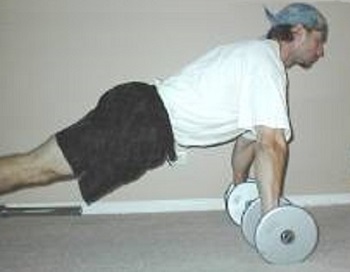“The Basic Push-up Is a Staple of Any Bodyweight Routine!”
However, once you start getting more advanced with the exercise, one of the best ways to increase difficulty is to increase instability.
And by increasing the instability of the push-up…
You can involve more muscle fibers of the chest.
Also challenge your core more aggressively all at the same time.
Here are a number increasingly difficult unstable push-up variations you can do…
Stage 1 – Dumbbell Push-Ups
Set two dumbbells on floor in approximate hand position.
Typical spacing you’d use for a push-up…
You will essentially be using the dumbbells as push-up handles.
The plates on dumbbell should be round (meaning they’ll roll) for maximum instability.
Use fairly lightweight dumbbells, e.g. 15 to 20 pounds each, so they’ll move around more.

This variation by itself is an excellent exercise for beginner to intermediate trainers.
You may do this variation with your knees on the floor.
(If you’ve not yet developed the strength for regular, full push-ups.)
Stage 2 – Swiss Ball Push-Ups
Set large Swiss Ball (inflatable exercise ball) on floor where you’ve got space.
Place your hands on the floor in your regular push-up position…
Next step is set your legs on top of Swiss Ball.
Your shins should be on the top of the ball…
Placed slightly to the sides so you can use them to maintain your balance.

Do push-ups in this position.
You will find that the ball will shift around as you are doing the exercise.
And you’ll be forced to move your body around to keep your legs on top of it.
The ball rolls slightly forward with you as you drop down to the bottom of push-up position.
Roll slightly back as you push yourself up…
Stage 3 – Swiss Ball/Dumbbell Push-Ups
Now that you’ve experienced instability at both ends of the push-up.
Next step is to put them both together and feel the burn!
Be sure you are comfortable with other two progressions before attempting this one.
And be sure you are not too close to anything should you lose your balance and roll off.
Set dumbbells up as you did in Stage 1…
And set the ball up as you did in Stage 2.
Place your hands on the dumbbells first then set your legs on the ball.

Now do push-ups on three rolling, unstable surfaces.
Make sure you come down and get a full range of motion.
The dumbbell handles allows you to go further down than if you were doing them on floor.
The first few reps may feel easy but as you continue…
You will notice a burning sensation in the deep muscle fibers of your chest.
Keep going…
This is where it gets good.
You’re hitting muscle fibers never effectively worked by standard chest exercises.
And if you think you’re getting a burn on the first set, just wait till you do a few more sets.
You’ll feel it across your abs and sides too.
The reason this exercise is so effective is simple: complete instability.
Since vast majority of chest exercises are performed in a reasonably stable position…
There are some muscle fibers that never get fully worked.
They aren’t required to work because you’re stabilized.
By placing your legs and both hands on independently moving objects…
You demand massive amounts of stabilizing work on the part of your pecs.
Your pecs never normally get this work with most chest exercises.
You’re stabilizing your entire body and limbs while you’re moving yourself up and down.
All this intense stabilizing work fires many more muscle fibers.
Much more than normally required for push-ups…
Resulting in a tremendously effective exercise for the chest.
Stage 4 – One Legged Swiss Ball / Dumbbell Push-Ups
Note: This variation of the push-up is extremely difficult and should only be attempted by advanced trainers.
You’ll experience the ultimate in instability when you lift one leg off ball doing push-up.

Place your shin directly on top of the ball and grip the dumbbells strongly.
There will be a lot of side-to-side movement in your lower body due to the instability.
Keep your abs and back tight…
And fight to keep yourself on the ball while you’re doing push-ups.
One tip you can do to really take advantage of this increased fiber activation…
Try doing a superset…
And going straight to a set of machine presses where load is stabilized.
Since your stabilizing muscles are not being worked in the machine press…
All of your effort can go into finishing off your already fatigued pec fibers.
Instead of trying to balance yourself…
Unstable Push-Ups
Flying in the face of conventional wisdom, Nick Nilsson is known around the world as the “Mad Scientist of Muscle” for a reason. Nine-time published author and fitness expert Nick Nilsson enters his lab every day with one obsession to experiment with and deliver something better, the kind of mind-blowing, extraordinary resistance training exercises that get results FAST. An expert in kinesiology, physiology and anatomy, Nick’s driving passion is helping people create the body they want, especially when nothing else seems to do the trick.
For more of Nick’s unique bodyweight training methods, check out http://www.thebestbodyweightexercises.com

